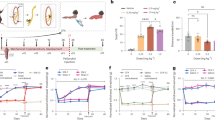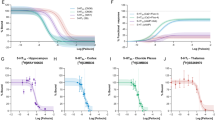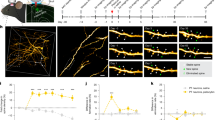Abstract
Schizophrenia patients exhibit impairments in prepulse inhibition (PPI) of the startle response. Hallucinogenic 5-HT2A receptor agonists are used for animal models of schizophrenia because they mimic some symptoms of schizophrenia in humans and induce PPI deficits in animals. Nevertheless, one report indicates that the 5-HT2A receptor agonist psilocybin increases PPI in healthy humans. Hence, we investigated these inconsistent results by assessing the dose-dependent effects of psilocybin on PPI in healthy humans. Sixteen subjects each received placebo or 115, 215, and 315 μg/kg of psilocybin at 4-week intervals in a randomized and counterbalanced order. PPI at 30-, 60-, 120-, 240-, and 2000-ms interstimulus intervals (ISIs) was measured 90 and 165 min after drug intake, coinciding with the peak and post-peak effects of psilocybin. The effects of psilocybin on psychopathological core dimensions and sustained attention were assessed by the Altered States of Consciousness Rating Scale (5D-ASC) and the Frankfurt Attention Inventory (FAIR). Psilocybin dose-dependently reduced PPI at short (30 ms), had no effect at medium (60 ms), and increased PPI at long (120–2000 ms) ISIs, without affecting startle reactivity or habituation. Psilocybin dose-dependently impaired sustained attention and increased all 5D-ASC scores with exception of Auditory Alterations. Moreover, psilocybin-induced impairments in sustained attention performance were positively correlated with reduced PPI at the 30 ms ISI and not with the concomitant increases in PPI observed at long ISIs. These results confirm the psilocybin-induced increase in PPI at long ISIs and reveal that psilocybin also produces a decrease in PPI at short ISIs that is correlated with impaired attention and consistent with deficient PPI in schizophrenia.
Similar content being viewed by others
Log in or create a free account to read this content
Gain free access to this article, as well as selected content from this journal and more on nature.com
or
References
Aghajanian GK, Haigler HJ, Bloom FE (1972). Lysergic acid diethylamide and serotonin: direct action on serotonin-containing neurons in rat brain. Life Sci 11: 615–622.
Aghajanian GK, Marek GJ (2000). Serotonin model of schizophrenia: emerging role of glutamate mechanisms. Brain Res Rev 31: 302–312.
Araneda R, Andrade R (1991). 5-Hydroxytryptamine2 and 5-hydroxytryptamine 1A receptors mediate opposing responses on membrane excitability in rat association cortex. Neuroscience 40: 399–412.
Braff DL, Geyer MA, Swerdlow NR (2001). Human studies of prepulse inhibition of startle: normal subjects, patient groups, and pharmacological studies. Psychopharmacology (Berlin) 156: 234–258.
Braff DL, Grillon C, Geyer MA (1992). Gating and habituation of the startle reflex in schizophrenic patients. Arch Gen Psychiatry 49: 206–215.
Braff DL, Stone C, Callaway E, Geyer MA, Glick I, Bali L (1978). Prestimulus effects on human startle reflex in normals and schizophrenics. Psychophysiol 15: 339–343.
Cadenhead KS, Geyer MA, Braff DL (1993). Impaired startle prepulse inhibition and habituation in patients with schizotypal personality disorder. Am J Psychiatry 150: 1862–1869.
Cadenhead KS, Light GA, Geyer MA, Braff DL (2000). Sensory gating deficits assessed by the P50 event-related potential in subjects with schizotypal personality disorder. Am J Psychiatry 157: 55–59.
Canal NM, Gourevitch R, Sandner G (2001). Non-monotonic dependency of PPI on temporal parameters: differential alteration by ketamine and MK-801 as opposed to apomorphine and DOI. Psychopharmacology 156: 169–176.
Davis M, Walters JK (1977). Psilocybin: biphasic dose-response effects on the acoustic startle reflex in the rat. Pharmacol Biochem Behav 6: 427–431.
Derogatis LR, Lipman RS, Covi L (1976). SCL-90 (Symptom-Check-List): Self-report symptom inventory. In: Guy W (ed). ECDEU Assessement Manual for Psychopharmacology. NIMH: Rockville/Maryland.
Dittrich A (1994). Psychological aspects of altered states of consciousness of the LSD type: measurements of their basic dimensions and prediction of individual differences. In: Pletscher A, Ladewig D (eds). 50 Years of LSD. Current Status and Perspectives of Hallucinogens. Parthenon Publishing: New York. pp 101–118.
Dittrich A (1998). The standardized psychometric assessment of altered states of consciousness (ASCs) in humans. Pharmacopsychiat 31: 80–84.
Dittrich A, von Arx S, Staub S (1985). International study on altered states of consciousness (ISASC). Summary of the results. Germ J Psych 9: 319–339.
Dulawa SC, Scearce-Levie KA, Hen R, Geyer MA (2000). Serotonin releasers increase prepulse inhibition in serotonin 1B knockout mice. Psychopharmacology 149: 306–312.
Fahrenberg J, Hampel R, Selg H (1984). Das Freiburger Persönlichkeitsinventar FPI. Hogrefe: Göttingen.
Geyer MA (1998). Behavioral studies of hallucinogenic drugs in animals: implications for schizophrenia research. Pharmacopsychiatry 31: 73–79.
Geyer MA, Braff DL (1987). Startle habituation and sensorimotor gating in schizophrenia and related animal models. Schizophr Bull 13: 643–668.
Geyer MA, Krebs-Thomson K, Braff DL, Swerdlow NR (2001). Pharmacological studies of prepulse inhibition models of sensorimotor gating deficits in schizophrenia: a decade in review. Psychopharmacology (Berlin) 156: 117–154.
Geyer MA, McIlwain KL, Paylor R (2002). Mouse genetic models for prepulse inhibition: an early review. Mol Psychiatry 7: 1039–1053.
Geyer MA, Swerdlow NR, Mansbach RS, Braff DL (1990). Startle response models of sensorimotor gating and habituation deficits in schizophrenia. Brain Res Bull 25: 485–498.
Gouzoulis-Mayfrank E, Habermeyer E, Hermle L, Steinmeyer AM, Kunert HJ, Sass H (1998a). Hallucinogenic drug induced states resemble acute endogenous psychoses: results of an empirical study. Eur Psychiatry 13: 399–406.
Gouzoulis-Mayfrank E, Heekeren K, Thelen B, Lindenblatt H, Kovar KA, Sass H et al (1998b). Effects of the hallucinogen psilocybin on habituation and prepulse inhibition of the startle reflex in humans. Behav Pharmacol 9: 561–566.
Graham FK (1975). The more or less startling effects of weak prestimuli. Psychophysiology 12: 238–248.
Haigler HJ, Aghajanian GK (1974). Lysergic acid diethylamide and serotonin: a comparison of effects on serotonergic neurons and neurons receiving a serotonergic input. J Pharmac Exp Ther 188: 688–699.
Hasler F, Grimberg U, Benz MA, Huber T, Vollenweider FX (2004). Acute psychological and physiological effects of psilocybin in healthy humans: a double-blind, placebo-controlled dose-effect study. Psychopharmacology 172: 145–156.
Johansson C, Jackson DM, Zhang J, Svensson L (1995). Prepulse inhibition of acoustic startle, a measure of sensorimotor gating: effects of antipsychotics and other agents in rats. Pharmacol Biochem Behav 52: 649–654.
Karper LP, Freeman GK, Grillon C, Morgan CA, Charney DS, Krystal JH (1996). Preliminary evidence of an association between sensorimotor gating and distractibility in psychosis. J Neuropsychiatry Clin Neurosci 8: 60–66.
Kumari V, Sharma T (2002). Effects of typical and atypical antipsychotics on prepulse inhibition in schizophrenia: a critical evaluation of current evidence and directions for future research. Psychopharmacology 162: 97–101.
Kumari V, Soni W, Mathew VM, Sharma T (2000). Prepulse inhibition of the startle response in men with schizophrenia: effects of age of onset of illness, symptoms, and medication. Arch Gen Psychiatry 57: 609–614.
Ludewig K, Geyer MA, Vollenweider FX (2003a). Deficits in prepulse inhibition and habituation in never-medicated, first-episode Schizophrenia. Biol Psychiatry 54: 121–128.
Ludewig K, Geyer MA, Vollenweider FX (2003b). Prepulse inhibition and habituation in first-episode schizophrenia. Biol Psychiatry 53: 118S.
Marek GJ, Aghajanian GK (1996). LSD and the phenethylamine hallucinogen DOI are potent partial agonists at 5-HT2A receptors on interneurons in rat piriform cortex. J Pharmac Exp Ther 278: 1373–1382.
Martin-Ruiz R, Puig MV, Celada P, Shapiro DA, Roth BL, Mengod G et al (2001). Control of serotonergic function in medial prefrontal cortex by serotonin-2A receptors through a glutamate-dependent mechanism. J Neurosci 21: 9856–9866.
McGhie A, Chapman J (1961). Disorders of attention and perception in early schizophrenia. Br J Med Psychol 34: 103–116.
McKenna DJ, Repke DB, Peroutka SJ (1990). Differential interactions of indolealkylamines with 5-hydroxytrypamine receptor subtypes. Neuropharmacology 29: 193–198.
Meincke U, Mörth D, Voss T, Thelen B, Geyer MA, Gouzoulis-Mayfrank E (2004). Prepulse inhibition of the acoustically evoked startle reflex in patients with an acute schizophrenic psychosis—a longitudinal study. Eur Arch Psychiatry Clin Neuosci 254: 415–421.
Meltzer HY, Nash JF (1991). Effects of antipsychotic drugs on serotonin receptors. Pharmacol Rev 43: 587–604.
Moosbrugger H, Oehlschlägel J (1996). FAIR. Frankfurter Aufmerksamkeitsinventar. Testmanual. Huber: Bern.
Neubauer AC, Knorr E (2006). Three paper-and-pencil tests for speed of information processing: Psychometric properties and correlations with intelligence. Intelligence 126: 123–151.
Nuechterlein KH, Dawson ME (1984). Information processing and attentional functioning in the developmental course of schizophrenic disorders. Schizophr Bull 10: 160–203.
Nuechterlein KH, Dawson ME, Green MF (1994). Information-processing abnormalities as neuropsychological vulnerability indicators for schizophrenia. Acta Psychiatr Scand 384(Suppl): 71–79.
Padich RA, McCloskey TC, Kehne JH (1996). 5-HT modulation of auditory and visual sensorimotor gating: II. Effects of the 5-HT2A antagonist MDL 100 907 on disruption of sound and light prepulse inhibition produced by 5-HT agonists in Wistar rats. Psychopharmacology (Berlin) 124: 107–116.
Parwani A, Duncan EJ, Bartlett E, Madonick SH, Efferen TR, Rajan R et al (2000). Impaired prepulse inhibition of acoustic startle in schizophrenia. Biol Psychiatry 47: 662–669.
Perry W, Braff DL (1994). Information-processing deficits and thought disorder in schizophrenia. Am J Psychiatry 151: 363–367.
Perry W, Geyer MA, Braff DL (1999). Sensomotor gating and thought disturbance measured in close temporal proximity in schizophrenic patients. Arch Gen Psychiatry 56: 227–281.
Perry W, Minassian A, Feifel D, Braff DL (2001). Sensorimotor gating deficits in bipolar disorder patients with acute psychotic mania. Biol Psychiatry 50: 418–424.
Quednow BB, Wagner M, Westheide J, Beckmann K, Bliesener N, Maier W et al (2006). Sensorimotor gating and habituation of the startle response in schizophrenic patients randomly treated with amisulpride or olanzapine. Biol Psychiatry 59: 536–545.
Riba J, Rodriguez-Fornells A, Barbanoj MJ (2002). Effects of ayahuasca on sensory and sensorimotor gating in humans as measured by P50 suppression and prepulse inhibition of the startle reflex, respectively. Psychopharmacology (Berlin) 165: 18–28.
Roth BL, Hanizavareh SM, Blum AE (2004). Serotonin receptors represent highly favorable molecular targets for cognitive enhancement in schizophrenia and other disorders. Psychopharmacology 174: 17–24.
Schell AM, Wynn JK, Dawson ME, Sinaii N, Niebala CB (2000). Automatic and controlled attentional processes in startle eyeblink modification: effects of habituation of the prepulse. Psychophysiology 37: 409–417.
Sipes TE, Geyer MA (1994). Multiple serotonin receptor subtypes modulate prepulse inhibition of the startle response in rats. Neuropharmacology 33: 441–448.
Sipes TE, Geyer MA (1995). DOI disruption of prepulse inhibition of startle in the rat is mediated by 5-HT2A and not by 5-HT2C receptors. Behav Pharmacol 6: 839–842.
Sipes TE, Geyer MA (1997). DOI disrupts prepulse inhibition of startle in rats via 5-HT2A receptors in the ventral pallidum. Brain Res 761: 97–104.
Spielberger CD, Gorsuch RL, Lusheme RE (1970). STAI, Manual for the State-Trait-Anxiety-Inventory. Consulting Psychologists Press: Palo Alto.
StatSoft Inc. (2005). STATISTICA (data analysis software system), version 7.1 www.statsoft.com. Tulsa, OK.
Swerdlow NR, Braff DL, Geyer MA (2000). Animal models of deficient sensorimotor gating: what we know, what we think we know, and what we hope to know soon. Behav Pharmacol 11: 185–204.
Swerdlow NR, Braff DL, Taaid N, Geyer MA (1994). Assessing the validity of an animal model of deficient sensorimotor gating in schizophrenic patients. Arch Gen Psychiatry 51: 139–154.
Swerdlow NR, Geyer MA (1998). Using an animal model of deficient sensorimotor gating to study the pathophysiology and new treatments of schizophrenia. Schizophr Bull 24: 285–301.
Swerdlow NR, Geyer MA, Braff DL (2001). Neural circuit regulation of prepulse inhibition of startle in the rat: current knowledge and future challenges. Psychopharmacology (Berlin) 156: 194–215.
Swerdlow NR, Hartman PL, Auerbach PP (1996). Changes in sensorimotor inhibition across the menstrual cycle: implications for neuropsychiatric disorders. Biol Psychiatry 41: 452–460.
Vollenweider FX (1998). Advances and pathophysiological models of hallucinogen drug actions in humans: a preamble to schizophrenia research. Pharmacopsychiatry 31: 92–103.
Vollenweider FX (2001). Brain mechanisms of hallucinogens and entactogens. Dialog Clin Neurosci 3: 265–279.
Vollenweider FX, Gamma A, Liechti ME, Huber T (1998). Psychological and cardiovascular effects and short-term sequelae of MDMA (‘Ecstasy’) on MDMA-naive healthy volunteers. Neuropsychopharmacology 19: 241–251.
Vollenweider FX, Geyer MA (2001). A systems model of altered consciousness: Integrating natural and drug-induced psychoses. Brain Res Bull 56: 495–507.
Vollenweider FX, Leenders KL, Scharfetter C, Maguire P, Stadelmann O, Angst J (1997). Positron emission tomography and fluorodeoxyglucose studies of metabolic hyperfrontality and psychopathology in the psilocybin model of psychosis. Neuropsychopharmacology 16: 357–372.
Vollenweider FX, Remensberger S, Hell D, Geyer MA (1999a). Opposite effects of 3,4-methylenedioxymethamphetamine (MDMA) on sensorimotor gating in rats versus healthy humans. Psychopharmacology 143: 365–372.
Vollenweider FX, Vontobel P, Hell D, Leenders KL (1999b). 5-HT modulation of dopamine release in basal ganglia in psilocybin-induced psychosis in man: A PET study with [11C]raclopride. Neuropsychopharmacology 20: 424–433.
Wittchen HU, Pfister H (1997). DIA-X-Interview. Swets Test Services: Frankfurt.
Acknowledgements
We thank Dr Felix Hasler for technical support. This investigation was financially supported by the Heffter Research Institute, Santa Fe, New Mexico, USA, the Swiss Federal Office for Public health (BAG Grant No. 00.001023), and by a NARSAD Young Investigator Award given to FH. Furthermore, Dr Boris B Quednow was supported by the Deutsche Forschungsgemeinschaft (DFG, Grant QU 218/1-1). Dr Mark A Geyer was supported by the US Veterans Affairs VISN 22 Mental Illness Research, Education, and Clinical Center and holds an equity interest in San Diego Instruments.
Author information
Authors and Affiliations
Corresponding author
Rights and permissions
About this article
Cite this article
Vollenweider, F., Csomor, P., Knappe, B. et al. The Effects of the Preferential 5-HT2A Agonist Psilocybin on Prepulse Inhibition of Startle in Healthy Human Volunteers Depend on Interstimulus Interval. Neuropsychopharmacol 32, 1876–1887 (2007). https://doi.org/10.1038/sj.npp.1301324
Received:
Revised:
Accepted:
Published:
Issue date:
DOI: https://doi.org/10.1038/sj.npp.1301324
Keywords
This article is cited by
-
High-resolution tracking of unconfined zebrafish behavior reveals stimulatory and anxiolytic effects of psilocybin
Molecular Psychiatry (2024)
-
Repeated low doses of psilocybin increase resilience to stress, lower compulsive actions, and strengthen cortical connections to the paraventricular thalamic nucleus in rats
Molecular Psychiatry (2023)
-
Psychedelics action and schizophrenia
Pharmacological Reports (2023)
-
Psilocybin mitigates the cognitive deficits observed in a rat model of Fragile X syndrome
Psychopharmacology (2023)
-
The Altered States Database: Psychometric data from a systematic literature review
Scientific Data (2022)



